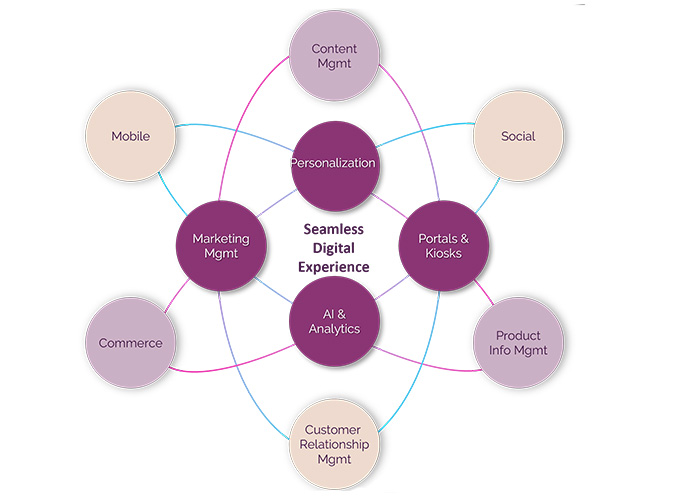A DXP can help you offer visitors a relevant, personal, compelling brand experience. Unleash the power.
What is a digital experience platform (DXP)?
Digital experience platforms (DXPs) are designed to anticipate what a customer wants, detect when customers are thinking about purchasing, and deliver offers across multiple touchpoints at the precise moment customers are ready to decide.
This is enterprise software that provides the foundation for companies to deliver connected, contextualized digital experiences across multiple touchpoints for the entire customer journey.
A DXP can help you offer visitors a relevant, personal, compelling brand experience. Unleash the power. #digital #experience #dxp #personalization
No one wants to get a message about a product they just purchased or click the link in a promotional social message only to be taken to an unrelated webpage. With third-party cookies on the way out, companies are looking for new ways to offer a more personalized customer experience. DXPs are now providing the necessary architecture to deliver multichannel customer experiences and gather customer insights.
However, it’s important that DXPs are configured with a human-centric approach. They are often a web of many different technologies, strategies, and workflows, but it is vital that the needs of the customer are at the heart of the entire process.
To achieve this successfully, there are a few key areas they need to cover:
User experience (UX) – Companies need to use the best of the technology available to them at this moment in time. Many competitors offer the same types of products and technology, but the way a company customizes and uses the technology to bring the user experience to life will win the race.
Multi-experience – Customers have high expectations, and companies need to match this by ensuring that journeys, experiences, and communications are seamless across every channel.
Customer experience (CX) – It’s important to find a way to create intuitive customer journeys. Companies must use all data available to them to predict a customer’s next action, which can help create individualized journeys. As you can imagine, the use of data is key here, because no single customer journey or behavior is identical. DXPs work best when they are informed by insightful, targeted data. This can then unveil useful information about customers that can be used at the next touchpoint of a similar customer profile.
Employee experience (EX) – Having motivated employees who are passionate about your business will help your company succeed. A keyway to ensure you are making the most of your DXP is to create an employee experience that can be adapted to the new world of work and accessible to a variety of professionals from different disciplines. You can achieve this with specific digital onboarding, which will enable the best staff to be employed.

Most companies have some of the components laid out above, but they are often implemented separately — with no connection between them. It’s important to integrate various marketing and IT applications and tools within one system.
The advantages of a digital experience platform
Unleashing the power of the DXP will allow you and your company to achieve the following great outcomes:
Omnichannel content management: The main benefit of a DXP is its versatility. Predecessors like legacy content management systems (CMS) and web experience management (WEM) solutions proved inadequate in effectively covering all these touchpoints. Firms no longer have to rely on separate tools for managing content.
Collaboration and cohesiveness: As channels grow, disconnects often occur between the teams managing these channels, which causes inefficiency and makes it harder to collaborate. With DXP and its integrated applications, this issue can be overcome. The ability to break content silos between teams is one of the key features of a DXP, due to the integrations already in place within the solutions.
Personalized experiences: With connections between all systems and channels, any journey can be tailored and personalized at each step of the way. Data can be grouped together and unified using a single platform, ensuring your company has a 360-degree view of customer behavior.
Positive, user-centric experience: A modern approach now needs a personalized approach. Modern DXPs analyze user data and behavior to execute sales and marketing activities efficiently. That’s why the majority of DXPs offer content recommendations, A/B testing and even AI-powered techniques that help fulfill the needs of the end user.
Elasticity: As your company and the market develop, new components or applications can easily be added to the DXP. These new components will continue to share data with the other elements and bring value as the organization grows. The flexible nature of DXPs means that adoption is easy, and integration with other tools and APIs is simple.
Anytime, anywhere: Cloud-based digital experience platforms are perfect for today’s new remote style of working. Many DXPs have service access policies with real-time alerts and monitoring systems.
Choosing the best DXP to use
There are a variety of digital experience platforms currently on the market, but Gartner has identified some clear leaders in this space — namely Adobe, Optimizely, Acquia and Sitecore. These platforms are in great demand, helping maximize customer experience, driving engagement at each touchpoint, and combining many applications to create a seamless end-user experience.
If you need guidance choosing, implementing, or customizing a digital experience platform to transform how you engage and interact with customers, it’s essential to find a partner with the right expertise.



